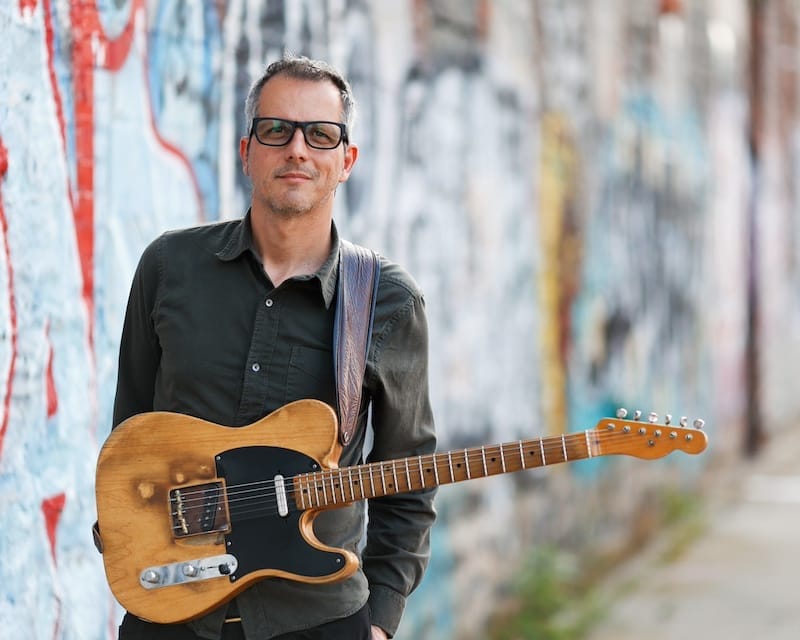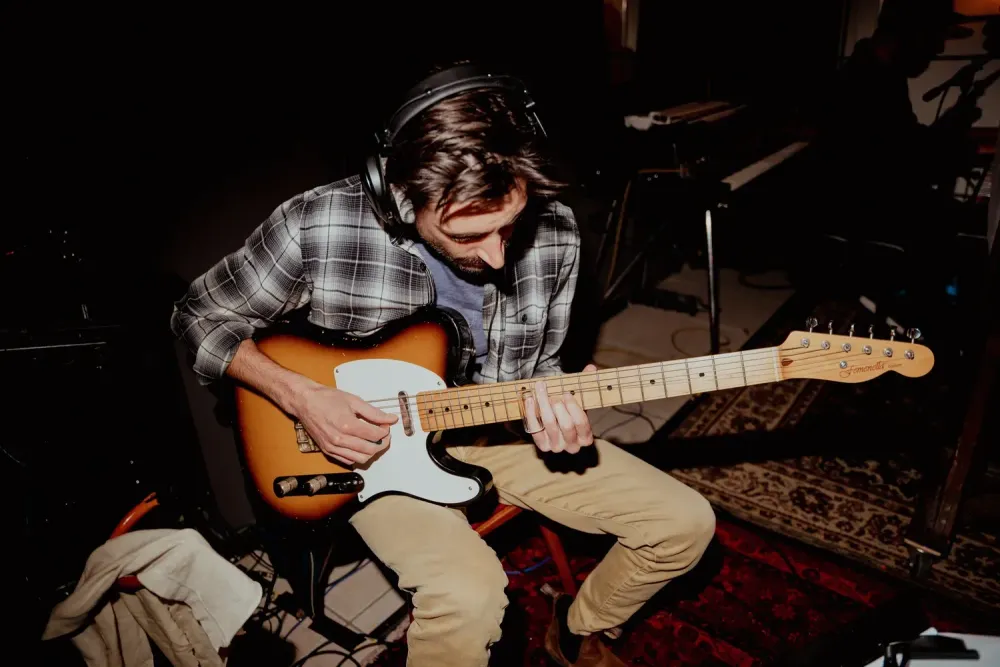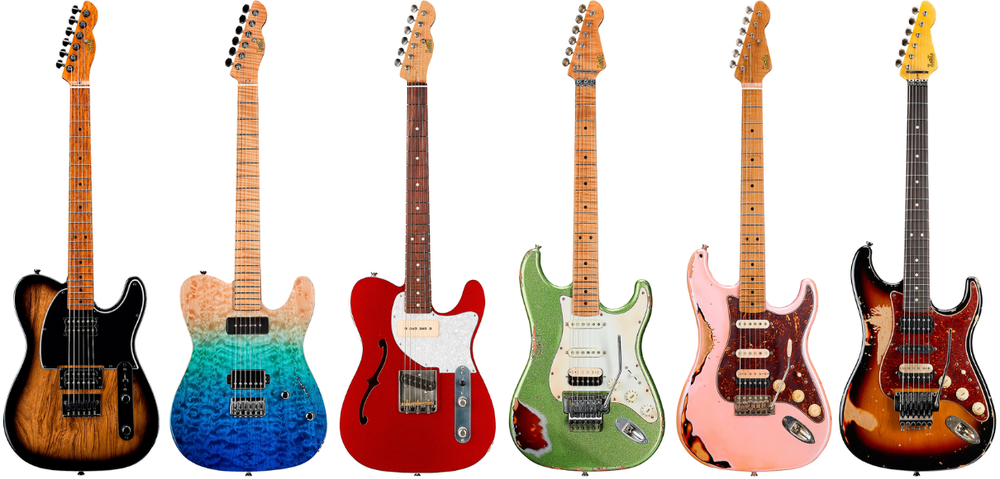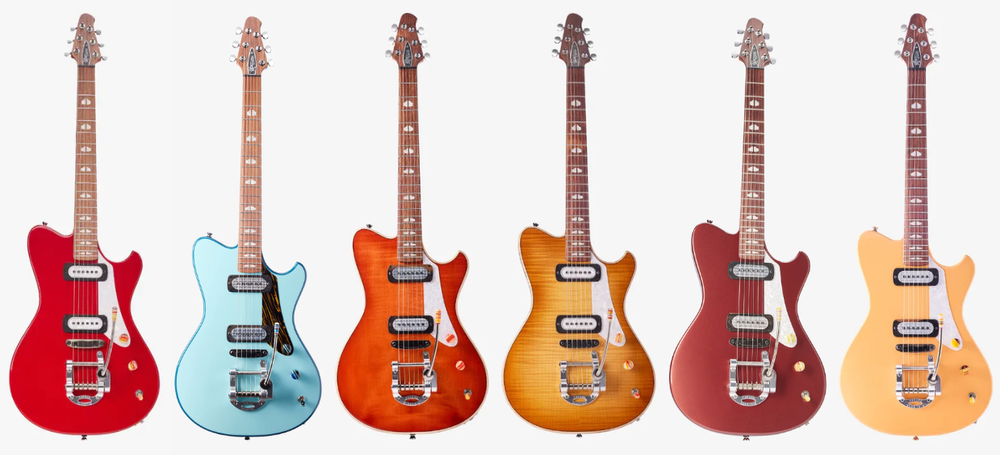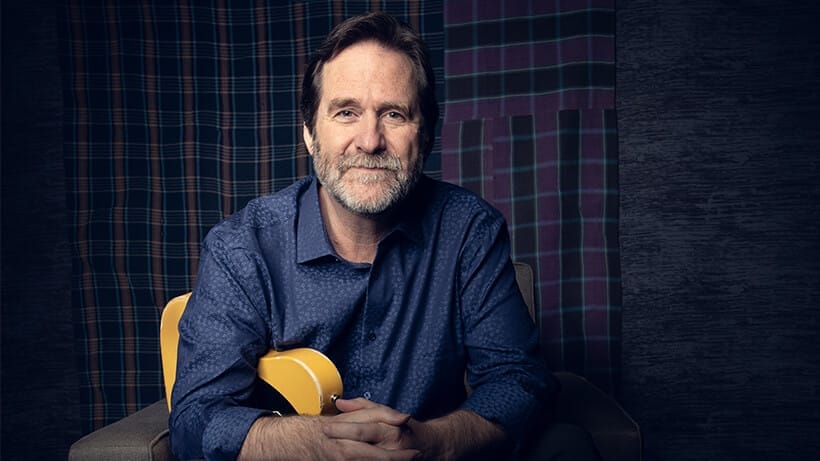
Exploring Sound: Luca Benedetti on Creativity, Influences, and the Gear That Shapes His Voice
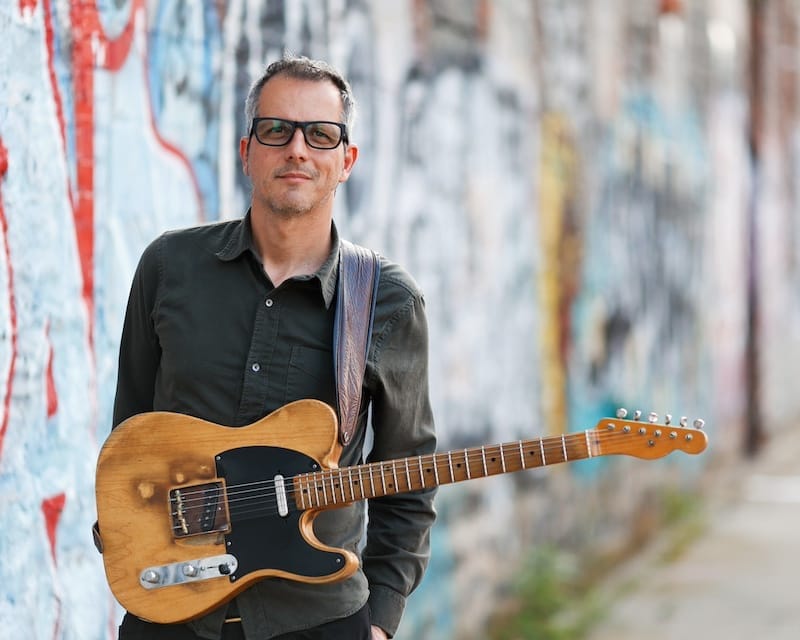
Luca Benedetti is a Brooklyn-based guitarist, composer, and producer known for his distinctive blend of jazz, blues, Americana, and beyond. A mainstay of the New York City music scene since the late 90s, he’s recognized for his expressive tone, stylistic range, and a deep-rooted feel that bridges groove-based traditions with modern improvisation.
Luca is often heard with his own instrumental trio featuring bassist Tony Scherr (Bill Frisell, Norah Jones) and drummer Tony Mason (John Scofield, Charlie Hunter), exploring a dynamic sound and mix of twang, groove, and improvisation. He is also well known for his long-running collaboration with Telecaster great Jim Campilongo, which has produced several celebrated projects—including the Western swing–inspired Jim Campilongo & Honeyfingers “Last Night, This Morning”, the intimate duet album Jim Campilongo & Luca Benedetti “Two Guitars”, and the more recent Miles Davis–influenced jazz-rock outing “She Loves the Coney Island Freak Show” with the Jim Campilongo 4tet.
As a sought-after sideman, session player, and producer, Luca has also performed, recorded, and toured internationally with artists including Ron Carter, Hermine Deurloo & Steve Gadd, Martha Redbone, Chris Lightcap, Erik Deutsch, Jon Cowherd, Zephaniah & The 18 Wheelers, The Brooklyn Boogaloo Blowout, Tubby, Speeding West, The Dang-It Bobbys, and The National Reserve.
Born in Rome, Italy, Luca left at an early age due to his father’s work in the airline industry. His childhood was unusual, and by the time he moved to the U.S. at 18, he had lived and traveled across all five continents—experiences that exposed him to a wide range of cultures and sounds, helping to shape his distinctive musical voice.
Luca attended both the Berklee College of Music and The City College of New York, where he studied under jazz legend Ron Carter. The two later collaborated on several occasions, including a memorable performance at the ASCAP Hall of Fame ceremony honoring Milt Hinton and Artie Shaw.
His playing and production work have earned praise from Relix Magazine, Vintage Guitar Magazine, and Saving Country Music, among others, while his guitar work has appeared in major advertising campaigns for McDonald’s, Subway, Rolex, Arby’s, The Cotton Industry, Axe, and AT&T. He also composed the soundtrack for KPI TV’s Lucha Libre: Life Behind the Mask.
Drawing on a global set of influences and a lifelong passion for blues, jazz, and improvisation, Luca Benedetti continues to carve out a singular musical voice—eclectic, expressive, and deeply groove-driven.
🎸 Q & A
How do you practice creativity — do you work on exercises, transcriptions, or simply explore ideas?
I'd say all of the above. I definitely have some exercises, and they usually involve setting certain rules or limitations. The goal is to break out of familiar patterns—the licks, habits, or rhythmic phrases we naturally gravitate toward.
Sometimes the limitation is physical. For example, I might only play with one finger, which changes my phrasing and speed, or I’ll restrict myself to a single string and improvise horizontally. Other times, I’ll stay within a four-fret range—one fret per finger—and play vertically through chord changes without leaving that area. These kinds of boundaries really help break away from one’s usual fretboard habits.
I also do melodic exercises. One idea is to simply remove a note from a scale. For example, in an A minor pentatonic (A, C, D, E, G), I might remove the third (C) and improvise with just four notes, which forces me to stay away from familiar licks, play differently, and often leads to new melodic ideas. Take a major scale and remove one note so it’s a six-note scale—you’ll inevitably play differently.
Harmonically, I’ve been practicing voicing triads that incorporate open strings. For instance, using the open low E string and fretting the other two notes of a triad on the A and D strings below—so E–B–G# for E major, E–C–G for C major, or E–C–A for A minor. It creates a beautiful texture and is the kind of exercise from which a song might emerge just from exploring new voicings.
As for transcribing, I used to do full solos, but these days I’m more likely to just grab short phrases or licks that catch my ear. I’ll then run them in different keys and fingerings and find ways to internalize them. I do, however, still transcribe full compositions.
Admittedly, my practice is somewhat less structured than it was in my formative years, but I love getting into a routine when I can. The feeling of progress is always so rewarding. For warm-ups and technique, I still run through the Segovia scale fingerings and some melodic minor and harmonic minor scale arpeggio ideas I picked up from guitar great Adam Rogers. There’s just less time for hours upon hours of practice as we age and other priorities in life catch up, so with the time I have, I’m often mostly focused on writing new music, learning new repertoire for an upcoming gig or recording, or perhaps digging deeper into a specific song.
Who were some of your biggest influences when you were developing your sound?
In 1982, when I was 11, I was living in Nairobi, Kenya, and the most rocking album we had in the house was the soundtrack to Grease. Otherwise, it was mostly Beethoven or some Italian folk/pop albums my parents had. One day some family friends who had just been to the U.S. brought two cassettes for my brother and me as gifts. One was Crosby, Stills & Nash’s Déjà Vu and the other was Led Zeppelin’s In Through the Out Door. We’d never heard of either of these bands, but my older brother chose first and picked Crosby, Stills & Nash, and I was left with one of Zeppelin’s more unusual albums—but I loved it dearly. Firstly for the mere fact that it was mine, but also because it, and Jimmy Page of course, truly rocked. Shortly after—not sure how—I heard of AC/DC, and Angus Young quickly became, and still is, one of my favorites. From there, I started getting into bluesier stuff—Jeff Beck’s Truth album with Rod Stewart really grabbed me, which then led me to his later classics, Blow by Blow and Wired.
Albert Collins was another huge influence. The Albert Collins record Iceman really stuck with me—it’s super funky blues, and that stinging Tele sound on 10 had a big impact on me. Of course, I listened to Clapton and Stevie Ray Vaughan at the time—they were both such a huge presence in the mainstream—but through them, I ultimately discovered the Black American blues artists that had an even deeper influence: all the Kings—Albert, B.B., and Freddie—plus Muddy Waters, Howlin’ Wolf, Otis Rush, Earl Hooker, Magic Sam, Lead Belly, Mississippi John Hurt to name a few.
Around ’89 or ’90, those were really formative years. I was about 19, and I hadn’t been playing long—started around 15—but I’d ended up at the University of Connecticut as a freshman, where dorm life exposed me to a lot of the classic rock I’d missed out on in my earlier years. Plus, this was a unique moment in time for instrumental guitar music, when a huge body of big-budget, highly produced albums were being released on major labels: Jeff Beck’s Guitar Shop, Danny Gatton’s Elmira Street, Steve Morse’s High Tension Wires, Joe Satriani’s Flying in a Blue Dream, Iceman by Albert Collins, Steve Vai’s Passion & Warfare, Eric Johnson’s Ah Via Musicom, Michael Hedges’ Taproot, Adrian Legg’s Guitar and Other Cathedrals, etc. Some of those prooved ultimately more influential than others but at the time I was just soaking it all in.
Eventually, I decided to take the idea of a music career more seriously and transferred to Berklee, where I started sinking my teeth into jazz. In terms of guitar players, Pat Martino was a huge influence, along with George Benson, Wes Montgomery, Joe Pass, and John McLaughlin—especially his work on Miles Davis’ Jack Johnson. Of course, the music of the original Berklee legends—Frisell, Scofield, Pat Metheny, and Mike Stern—was omnipresent while I was there, and they all were and continue to be an inspiration. I realize this seems like a linear timeline, but it isn’t, and I certainly don't recall when I first heard all the players. Steve Cropper eventually became a big inspiration, but I'd actually been listening to him since my early teens because of an Otis Redding album my parents often played. Same with Ry Cooder—his haunting soundtrack to Paris, Texas had been with me from early on.
Other important influences off the top of my head are the country-funkiness of Albert Lee and James Burton, Leo Nocentelli and The Meters, and the more modern jazz players—Kurt Rosenwinkel, Jeff Parker, Nels Cline—the list just goes on and on. I also finally heard Blake Mills live recently—truly mesmerizing sounds and playing—really different and inspiring. The duo albums by Skúli Sverrisson and Bill Frisell are something I’ve really been into lately as well.
Last but not least, the music from the places I was fortunate to visit has also played a huge part in my sound. I lived in Brazil, Ghana, and Ethiopia, to name a few, and each has its own distinctly rich musical traditions that I was able to absorb long before the ease of access that digital platforms now offer us. If I start naming all the artists that influenced me just from those countries, we’ll never end! I consider myself very, very lucky for having had those experiences.
You blend elements of jazz, blues, Americana, and roots — how did that hybrid approach develop in your playing? What advice would you give to a guitarist who’s trying to bridge genres like you do?
The main advice I would give is to be honest with yourself about what made you love playing music and your instrument in the first place. We all go through journeys. I’m fortunate that I was always curious about a lot of different kinds of music and was open to exploring them. Growing up, there was a lot of tape trading and recommendations from record store clerks—“Oh, if you like that, then you need to check THIS out!”—which also exposed me to a wide variety of artists. It was a much less predictable and more exciting way to discover music versus the playlist algorithms of today. Plus, it was a time when I, and most folks, would really sit and absorb full albums. Our attention span has greatly suffered with all the distractions of modern digital life and the overwhelming amount of music available at our fingertips for free.
When I went to Berklee, I definitely narrowed my focus and got very into jazz, which was valuable but also restrictive. Once I left and moved to NY, it took years to deprogram from the academic-music mindset and reconnect with the music I truly loved. Much of it revolved around the basic I, IV, and V chords, which seemed almost taboo to enjoy after Berklee. To be clear, I loved my time there and all that I learned, but music school can also lead to overcomplication and not making “music”. In retrospect, going to music school and knowing what you want to get out of it ahead of time, is a good idea. It’s also great for the connections you’ll make.
Around 2009, I had a bit of a turning point and began embracing much of the bluesier, raunchier, funkier music that originally inspired me. Along with that came a renewed pursuit of tone via tube amps, tinkering with pickups, etc. This is also when I started going to hear Tele-great Jim Campilongo more often at The Living Room in NY’s Lower East Side. I’m fortunate to now call him a friend and collaborator on a number of great projects.
But I digress—my advice is: listen to everything, but don’t feel obligated to like it all. Give music a chance, even in genres you don’t normally gravitate toward, but also filter what truly resonates with you. That’s how you can try to keep your musical journey honest and meaningful.
You’re often seen with a Telecaster — what do you love about that guitar, and how does it fit your sound?
I didn’t commit to a Telecaster until about 15-20 years ago. Before that, I mostly played Strats and 335-style guitars. But at some point, it all clicked. I was a fan of Albert Collins, Steve Cropper, Roy Buchanan, and Danny Gatton, and again, seeing Jim Campilongo in New York really opened my eyes to the Telecaster’s unique and special voice.
I really connect with both the neck and bridge pickups. The neck pickup captures that archtop sound, especially with flatwound strings, while the bridge pickup can really cut in a way no other guitar’s bridge pickup does. I used to ignore the middle position, but I’ve come to appreciate it more recently. I’m generally not a fan of humbuckers or Charlie Christian neck pickups on a Tele because I like going from the quieter neck pickup to the louder boost of the bridge. It really throws me off if the neck is louder—it kind of takes away some of the Tele magic. I also have an out-of-phase “quack” setting that gives me that funky thing à la James Burton, Waylon Jennings, and Albert Lee.
At the end of the day, the Telecaster is just a very versatile guitar, and I’m clearly not the only one to think so!
Can you talk about your amp and effects setup — what’s essential for you?
A cable! I really don’t mind playing dry as long as it’s through a good amp—specifically, a good tube amp. I’m really an amp nerd, much more so than guitars, and I’ve gone pretty deep, even learning to fix and maintain all my old Fenders. I was lucky to collect a lot of vintage Fender amps from different eras long before websites like Reverb existed that inflated prices and obliterated almost all the good deals.
The next most essential effect for me is tremolo, which many of my amps have. I have a Fender Brown Deluxe, a Fender Brown Princeton, a Fender Vibro Champ—all with great tremolos—and a Tweed Tremolux. I’d be happy with just that. Reverb is also great of course and kind of essential if the room you’re playing in is super dry, but I use it very sparingly. I love my ’66 Blackface Vibrolux Reverb, which has both tremolo and reverb. For me, those two effects alone are generally more than enough. If I want verb and trem on my “dry” amps, I’ll use a Strymon Flint.
I do, however, also have a large board I use, in particular with a couple of great singers I play with now, Joy Askew and Margo Valiante. Their music requires a setup that’s often atmospheric and textural. It has a Tube Screamer and a Jam Pedals Rattler for long sustain, Strymon Cloudburst for ambient reverb, Jam Pedals Delay Llama, and their RetroVibe. I also use a JHS Little Big Fuzz for sputtery fuzz sounds.
What do you think most players misunderstand about developing their own voice on the instrument?
I don’t know that I have a clear answer to that—assuming that I even fully understand what it takes to develop my own voice. I think it goes back to what I said earlier about being honest with yourself and also about filtering—not just filtering what you listen to, but also filtering what you're playing. Even if we learn something through a transcription or emulate what someone else does, it might not be honest to what you actually want to hear. At the end of the day, it’s not your voice.
I think one of the most important things you can do is at least know what you don’t want to sound like. It’s hard to know exactly where your voice will go, but we usually recognize what doesn’t feel right. Use that self-criticism to find the things that truly excite you, and then be honest about it—if something grabs you, play it with full intent and honesty. Bring that into your performances, whether you’re playing alone or for other people.
Influences don’t have to sound like you. I love Allan Holdsworth—what a genius—and I can’t play anything like him. But his artistry, energy, and virtuosity can still influence me. The notes, technique, or sound might not be things I’d use, but they can still inform how I approach my own music. It’s not just about people in the same genre; it’s about being true to what you love and, perhaps, what you’re good at.
What's one musical lesson that stuck with you throughout your career?
If I were to point to a specific music lesson, I’d highlight my years doing an M.A. at City College in New York, where the ensemble teacher was legendary bassist Ron Carter. He gave us a lot of professional advice that I still value today. In his class, he would bring his own songs and have us rearrange them. He emphasized leaving with experience in writing arrangements and creating clear, professional charts. He also stressed the importance of being organized as a bandleader—knowing the forms, planning who took solos ahead of time, and being prepared for gigs, including showing up on time and dressing appropriately. Those lessons in leadership and professionalism have stuck with me.
On a more general level, the biggest musical lesson for me is to be kind—to yourself and to others—and have fun! Music is challenging, and we all deal with self-doubt and ego, both our own and others’. Being supportive, offering encouragement, and acknowledging someone’s effort—even if they’re having a rough night—makes a huge difference. It’s as easy as saying, “You sound great,” to someone as they walk off stage instead of, “What year is that guitar?” So, in addition to the technical lessons, I’d say: be patient, be kind, and be supportive.
What's next for you musically? Any projects or goals you're working on?
Yeah, we’re going back into the studio soon with my trio—with Tony Scherr and Tony Mason. I’m really excited about it. It’s happening in a few weeks, and right now it’s crunch time getting the arrangements and music together. New tune ideas are still coming out, and we only have two days in the studio, so it’s going to be intense. I’m looking forward to capturing the group’s development on this next recording, as we’ve been refining our sound over the years.
Other goals include booking more tours for my own music. I’ve had some nice runs on the West Coast and am working on something in Europe next year. Beyond that, it’s all about continuing to develop my sound and my music.
Website | Instagram | Spotify | Apple Music
Recommended Listening & Watching:
- 🔊 We'll Get There album - Apple Music | Spotify
- 🔊 Ride Awhile album - Apple Music | Spotify
- 📺 Luca Benedetti Trio - Seamonster Lounge - 2024-06-28
- 📺 Luca Benedetti Trio - Storm Warning (Dr John cover) at Bar Lunatico NY
News & Notes

- Fender announced the Kingfish Delta Day Telecaster Deluxe. The signature tele for Christone "Kingfish" Ingram features custom Kingfish humbucking pickups, a V-shaped roasted maple neck, and a 12" radius rosewood fretboard. Offered in Mississippi Night (purple) and Daphne Blue.
- Fender also announced a new Josefina Hand Wound Tomatillo Telecaster® Pickup set. Hand-wound in the Fender custom shop by master pickup winder, Josefina Campos, the Tomatillo Telecaster pickups are crafted around alnico 2 magnets, designed to deliver a sweet, flavorful tone.
- Martin announced 2 new signature Jason Isbell acoustic guitars - the 0-17 and 0-10E. Isbell partnered with Martin to create two guitars inspired by the 1940 Martin 0-17 he used to record his latest album, Foxes in the Snow.
- PJD Guitars announced a new “Origin Pro” series. While PJD's higher-tier guitars are hand-made in the U.K., the Origin Pro series is made in Indonesia, allowing them to offer their Carey and St. John models at a more budget-friendly price. Offered through Andertons Music, they are offered in Sea Blue, Charcoal Burst, Original Burst & Forest Green Burst colors, feature roasted Maple necks, and are loaded with PJD Custom Shop designed pickups.
- Trey Anastasio joined Cory Wong on his podcast. He broke it up into 2 episodes, with Part 1 being released so far: Apple | Spotify
- Fender released new Mustang® LTX100 and Mustang® LTX50 guitar amps.
Enjoy this newsletter? Please forward to a friend or hit reply to share your thoughts.🤘
